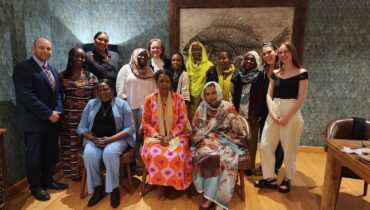On December 19, 2011, President Obama launched the United States National Action Plan (NAP) on Women, Peace and Security (WPS) through Executive Order 13595. Last week, USAID hosted a Third Anniversary Event to commemorate this fundamental change in how the U.S. government approaches diplomacy, development and defense to support women in conflict zones. The event featured speakers from USAID; the Bureau of Democracy, Human Rights and Labor; the National Security Council and the Georgetown Institute for Women, Peace and Security. The panel focused its remarks on successes and barriers to NAP implementation, including research gaps, in anticipation of the three-year review of the U.S. NAP.
The U.S. NAP represents the government’s express commitment to realizing UN Security Council Resolution 1325 (2000), which seeks to increase women’s participation in peacebuilding and protect women from conflict-related sexual violence. Bringing more women to negotiation tables, integrating solutions and justice for women into peace agreements, and increasing women in security and justice systems “is not just a nice thing to do, it is a strategic thing to do,” said Karen Hanrahan, Deputy Assistant Secretary, Bureau of Democracy, Human Rights and Labor (DRL) at the U.S. Department of State.
Echoing this sentiment, those in the WPS field must recognize that “we cannot sell the agenda with rights-based arguments alone,” said Dr. Robert Egnell, Senior Faculty Advisor at the Georgetown Institute for Women, Peace and Security. “[And] we are still [unfortunately]…in a startup phase 15 years after the initiation of the agenda.” We need evidence-based research, which Egnell acknowledged tends to indicate a desire for quantitative figures—a report that can show “including women at the peace table is 70% more effective,” for example. However, there are so few cases of women’s inclusion in peace talks that it would be statistically insignificant research to form quantitative analyses at this juncture. Instead, Egnell suggested that we emphasize qualitative examples so we can begin to understand how women impact peace processes. Another facet of the WPS research agenda that Egnell raised is the need to shift from viewing women as victims to seeing them as change agents, so that 1325 can have the intended empowering effect.
To gauge the U.S. government’s success in implementing its NAP, Executive Order 13595 called for a comprehensive review after three years—which is due to take place in 2015. Contemplating the successes and challenges of the U.S. NAP, Carla Koppell, Chief Strategy Officer of USAID Office of the Administrator, shared her reflections on a recent trip to Uganda: There is a palpable difference in how individuals engage in conversations around gender today, versus three or four years ago. “Today, everyone at the mission thinks about gender issues as woven into the entire post-conflict reconstruction program.” Additionally, Dr. David Yang, Deputy Assistant Administrator, Bureau of Democracy, Conflict and Humanitarian Assistance at USAID, highlighted that USAID has made significant progress in the past three years. Signs of this progress include the integration of WPS objectives into the overall USAID business model, mandatory country-level and project-level gender analysis, gender training for staff, and adopting mission orders at the country level on gender integration. While these are welcome indicators of success, many challenges to fully implementing the U.S. NAP still exist.
There are several tactical choices that the U.S. will need to address when reviewing its NAP and overall implementation strategy: Should there be a focus on rights based arguments or strategic arguments? An emphasis on gender perspectives or integration, on gender mainstreaming or specific functions? Where should the government initiate the process of change? After addressing these concerns, the U.S. will need to think about how to alter “centuries of ingrained bureaucratic processes…there are questions about how to effectively integrate organizational change that we still don’t have answers to,” Egnell indicated.
It is a point of critical importance: How do we get the appropriate stakeholders—at home and abroad – to accept this agenda and meaningfully incorporate it into preexisting structures? This is a fundamental challenge of working in the WPS field, especially in crisis environments where governments experience problems of political will and capacity, and cannot always plan beyond the urgency of the conflict at hand. Furthermore, we need to ascertain how “we address societal discrimination and cultural values associated with the WPS effort,” stated Regina Waugh, Director of Human Rights and Gender at the National Security Council. She asserted, “the type of social change that needs to happen is not an overnight thing.”
Hanrahan remains positive, noting the U.S. is “trying to improve how we do business” and is “committed to leading by example,” but cautions, “we must also be somewhat humble as we review [our] global track record.” In light of the upcoming 15th Anniversary of UNSCR 1325, the third anniversary of the U.S. NAP and its upcoming review, and the post-2015 development agenda, Hanrahan shared, “We are viewing 2015 as the year of women, peace and security,” and “we are pushing to place gender equality and women and girls at the heart of the post-2015 development agenda.”
In addition to the identified priorities, research gaps, successes and challenges, the U.S. and all countries committed to the WPS agenda will need to explore how to move beyond the numbers when assessing gains in women’s political participation. Yang stressed, “It is not just about increasing quotas, it is about devising, conceptualizing and achieving women’s true influence, power and leadership.” This is the essence of UNSCR 1325, and one of the fundamental goals of the WPS agenda.
As Koppell underscored in her remarks, “civil society is essential” to government accountability and mainstreaming this commitment across sectors. The involvement of civil society will be indispensable in designing a review of the U.S. NAP that addresses these identified gaps and ultimately strengthens the government’s commitment to effectively implementing 1325.



